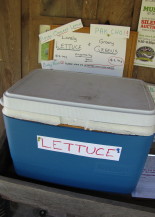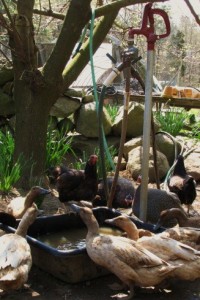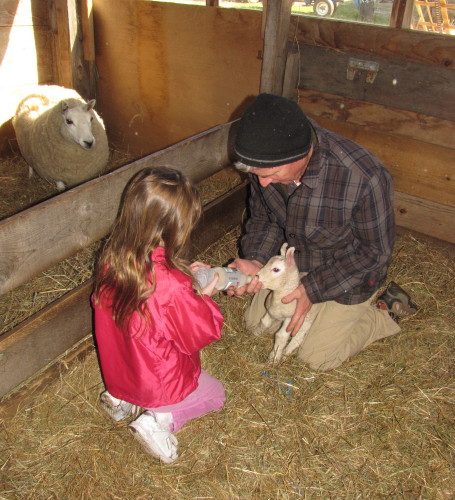 I watched a goat give birth this morning. It was maybe the coolest thing I’ve ever seen.
I watched a goat give birth this morning. It was maybe the coolest thing I’ve ever seen.
 I was going to blog about something else today. Actually yesterday. And then yesterday went by and now today has, too. That is how my life goes these days, here in my new world. When I get up, I think there is something so important to do that I must focus entirely on it—be productive, get it done, do my work. But the universe always has other plans for me. And if I just remember to pay attention to that, I get to experience the most amazing things.
I was going to blog about something else today. Actually yesterday. And then yesterday went by and now today has, too. That is how my life goes these days, here in my new world. When I get up, I think there is something so important to do that I must focus entirely on it—be productive, get it done, do my work. But the universe always has other plans for me. And if I just remember to pay attention to that, I get to experience the most amazing things.
So while Roy and I went over to the farm especially early this morning—ostensibly to water and harvest and be out of there by 8—Basil and Snowflake, two pygmy goats, had other plans (the goat pen is right next to our vegetable garden). By the time we got there, Basil had given birth during the night to two healthy kids, both females (does). One was a little grey and white patchy thing, already cleaned up and awkwardly skipping and hopping around like a tipsy gypsy. She even managed to climb on mama’s back. The other little girl was black with white ears, and she was much bigger (and less squirmy) than her sister.
 Snowflake was in labor. Never having given birth myself, I wasn’t exactly sure by her bleating and writhing what the whole timing scenario was! Fortunately, Randy and Rebecca (the farm owners) soon arrived to check on Snowflake. Randy had been up during the night helping Basil along with the second kid, who needed a small tug to get out. Basil, though, as it turns out, is a veteran Mom. For Snowflake, this was the first time.
Snowflake was in labor. Never having given birth myself, I wasn’t exactly sure by her bleating and writhing what the whole timing scenario was! Fortunately, Randy and Rebecca (the farm owners) soon arrived to check on Snowflake. Randy had been up during the night helping Basil along with the second kid, who needed a small tug to get out. Basil, though, as it turns out, is a veteran Mom. For Snowflake, this was the first time.
Randy talked soothingly to her, but let her push. Two little white hooves followed by two little black legs appeared. And then, as we all stood watching (Snowflake had positioned herself in the breezeway of the shed so we could all see), swoosh!—the kid spilled out in a tidy (wet) bundle. Not a few seconds later it lifted its head and squiggled in the hay. Bravo Snowflake!
The second kid apparently followed not long after. I missed that but came back with my camera a short while later in time to watch Snowflake lick them (a little black doe and a little black buck) clean. Even though I had emptied the chip in my camera, I still ran out of space after a half-hour or so. I was mesmerized.
Frankly, I was just as excited about the goats (and the appearance of the first sugar snap peas in the garden) as the other news I was going to blog about—that the second printing of Fast, Fresh & Green arrived in warehouses yesterday.
I have to admit, I have very mixed feelings about bragging about my book. I wasn’t brought up to flaunt success, and yet I know two things: One, I didn’t do this book all by myself, and the folks who helped me deserve to share in the good news. I owe it to them (and these are not the people who are logging on to Facebook and Twitter on a regular basis, so they are not going to see the reviews) to keep them updated. Secondly, I know what it feels like to be grateful. In my post midlife-crisis world, not only do I get to be present for a lot of cool stuff, but I also get to know that terrific feeling of gratitude—of knowing you’re the recipient of good karma that you’re not necessarily wholly responsible for.
 So to celebrate Fast, Fresh & Green (and those sugar snap peas I’m going to harvest for the farm stand tomorrow!), here’s a quick recipe, Sautéed Sugar Snaps with Salami Crisps. It’s one of my very favorites in the book for its inarguable simplicity. And for anyone with lots of time on their hands (that’s you, Mom and Dad!!) who would like to see some of the recent coverage of FFG, there’s a list of links after the recipe. I’m particularly grateful to the articulate Tom Philpott of Grist.org for acknowledging my primary goal—to encourage people to cook at home more. To me, there’s no better way to practice being present—and grateful—than spending time cooking (and eating) at home every day with friends and family.
So to celebrate Fast, Fresh & Green (and those sugar snap peas I’m going to harvest for the farm stand tomorrow!), here’s a quick recipe, Sautéed Sugar Snaps with Salami Crisps. It’s one of my very favorites in the book for its inarguable simplicity. And for anyone with lots of time on their hands (that’s you, Mom and Dad!!) who would like to see some of the recent coverage of FFG, there’s a list of links after the recipe. I’m particularly grateful to the articulate Tom Philpott of Grist.org for acknowledging my primary goal—to encourage people to cook at home more. To me, there’s no better way to practice being present—and grateful—than spending time cooking (and eating) at home every day with friends and family.
Sautéed Sugar Snaps with Salami Crisps
___________________________________
1 ounce very thinly sliced Genoa salami
1 teaspoon extra-virgin olive oil
½ pound sugar snap peas, tails removed
1/8 teaspoon kosher salt
___________________________________
Stack the salami slices and cut them across into ¼-inch wide strips. Pull the strips apart and spread them in one layer on the cutting board; they are much easier to add to the pan when they are not clumped together.
In a large (12-inch) nonstick skillet, heat the 1 teaspoon olive oil over medium heat. When the oil is hot (it will loosen up and spread out), add the sugar snap peas and season them with the 1/8 teaspoon salt. Toss well. Cook, stirring occasionally, until the peas turn bright green, blister, and begin to turn a very light golden brown in spots, about 3 minutes. Add the salami strips and toss well.
Continue to cook, stirring occasionally, until the peas are browned in spots on both sides and the salami strips have shrunken, turned a darker brown color, and feel crisp, 3 to 4 minutes. (The salami will probably be crisp on the edges but still somewhat pliable after 3 minutes. You can stop at that point if you do not want to cook the peas further, but I like the texture of the fully crisp salami, and the peas stay crisp even when cooked more.) Transfer to a serving platter or dinner plates.
Serves 3
_____________________________________________________________
Here are links to some recent reviews of Fast, Fresh & Green.This is only a partial list and my thanks go to the many bloggers who have taken FFG for a test spin and enjoyed the ride!
How to Be Fast, Fresh & Green in the Kitchen (Grist)
To Market, To Market: 10 Top Summer Cookbooks (NPR)
Book Report: We Pick 11 New Cookbooks (Washington Post)
Ideas For What to Do With Summer’s Bounty (Associated Press)
Favorite Cookbooks: Fast, Fresh & Green (Eat Well, Eat Cheap blog)










































